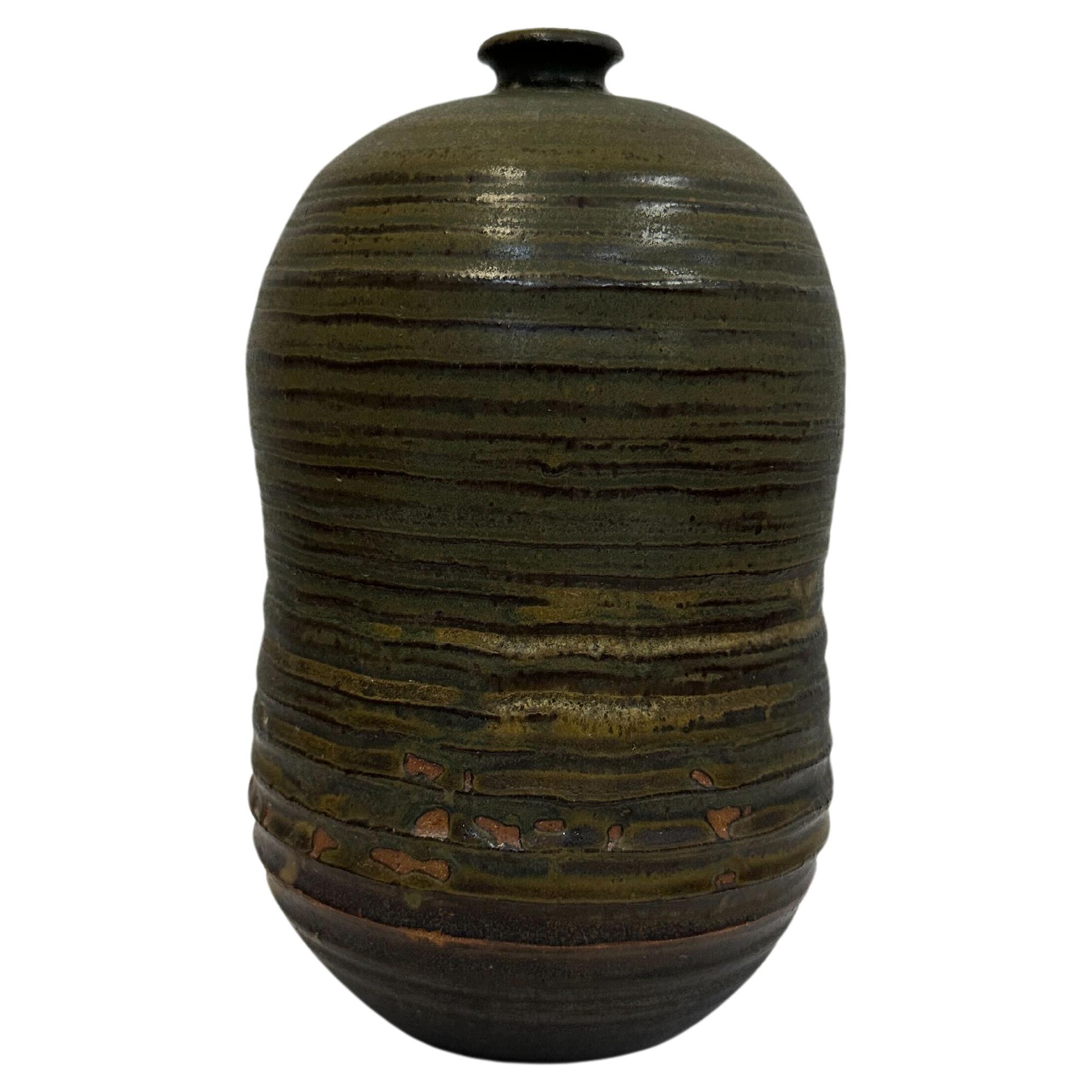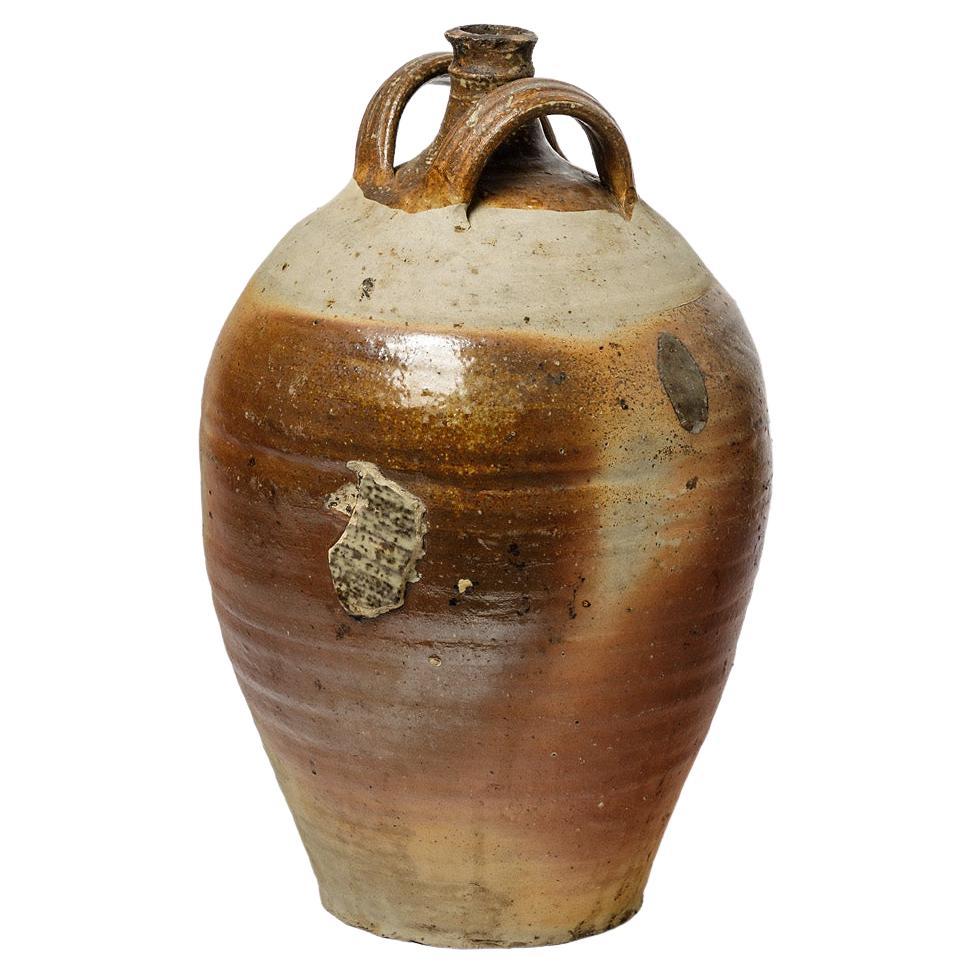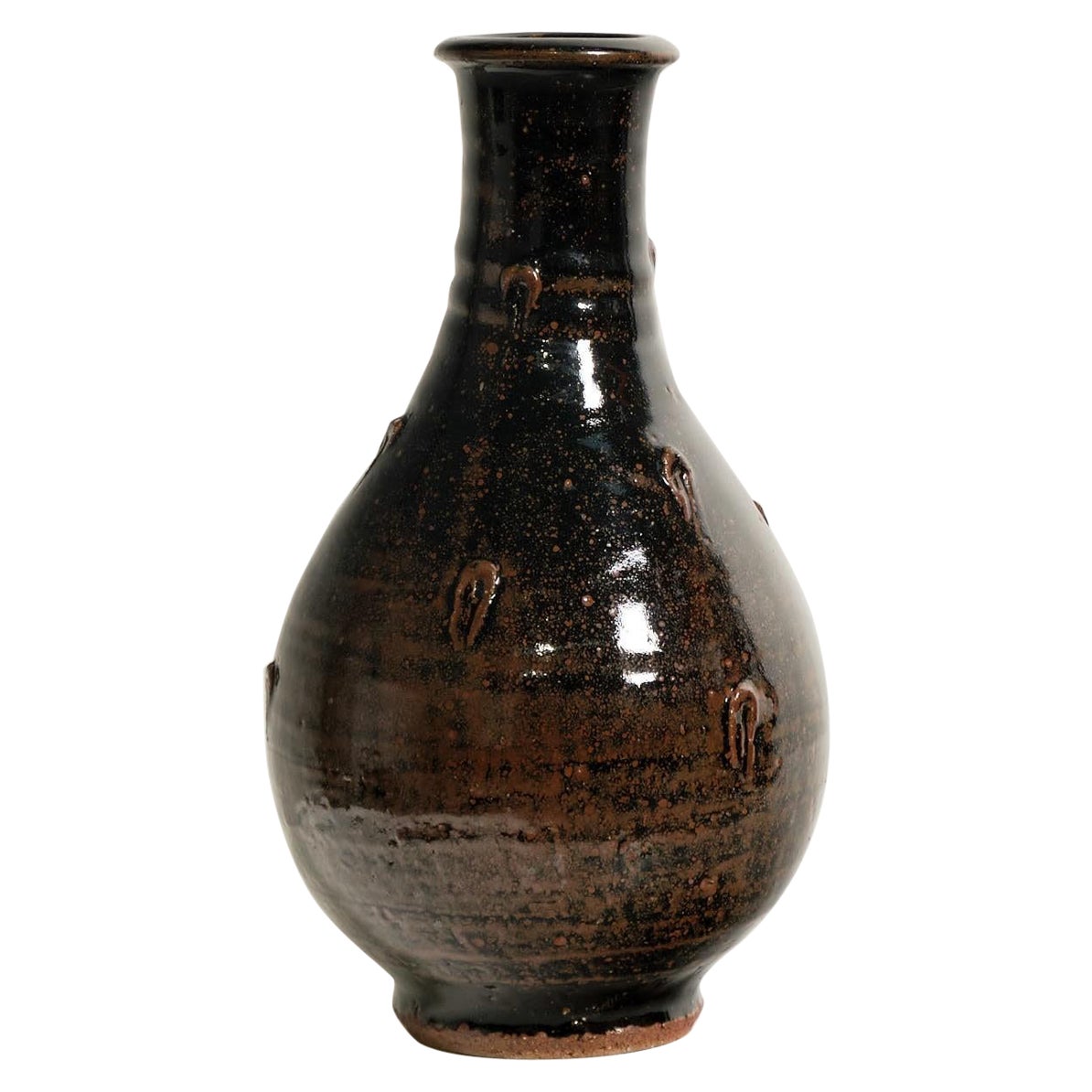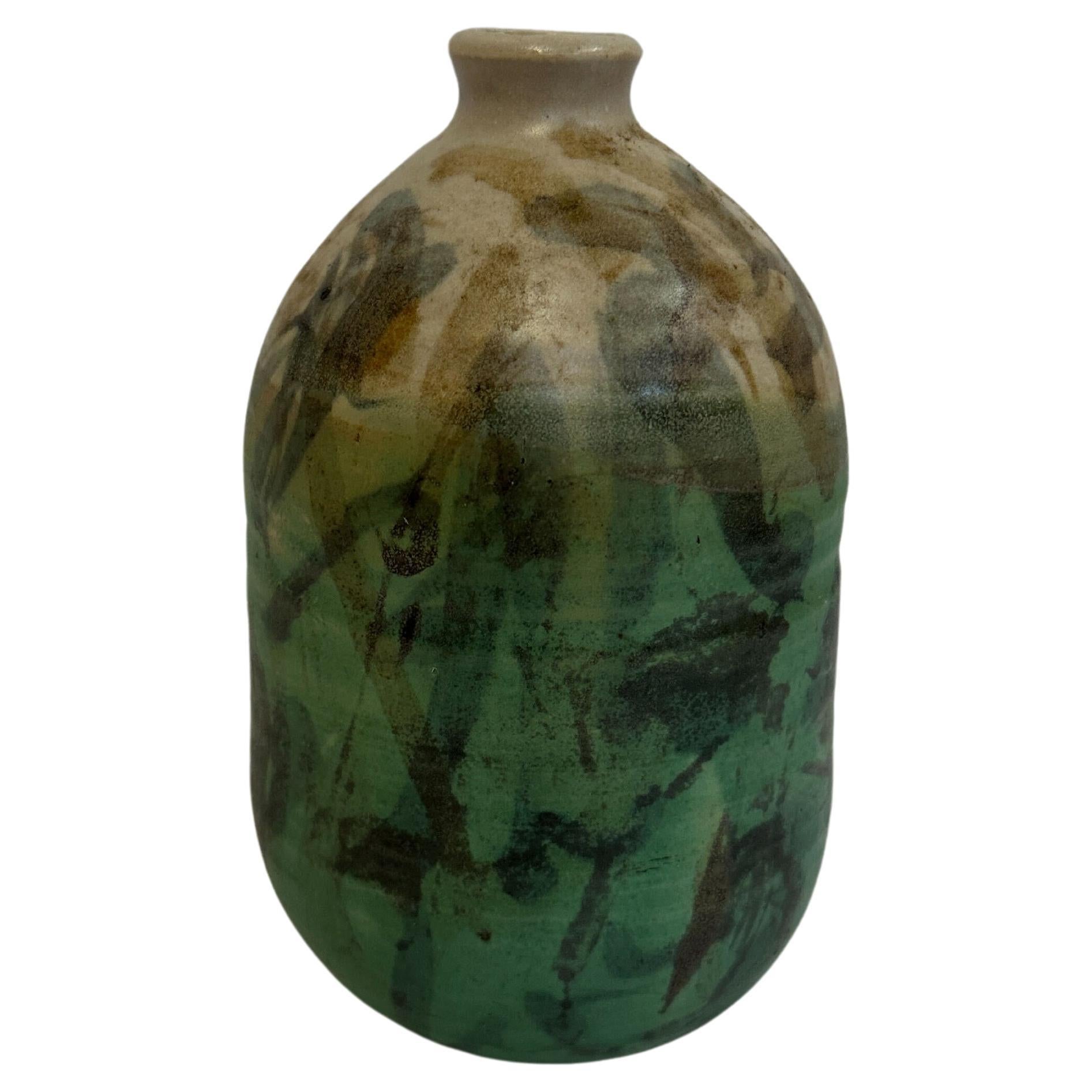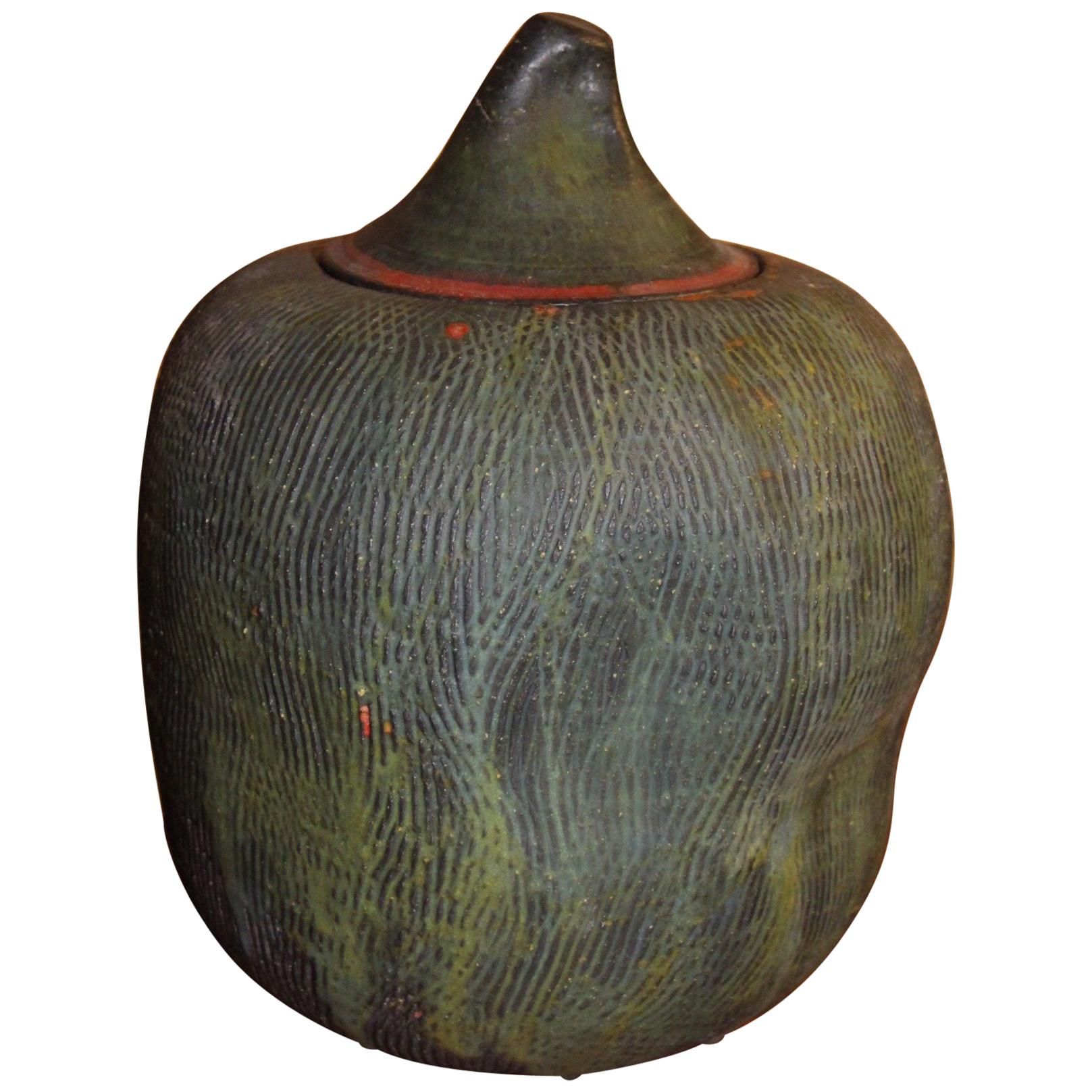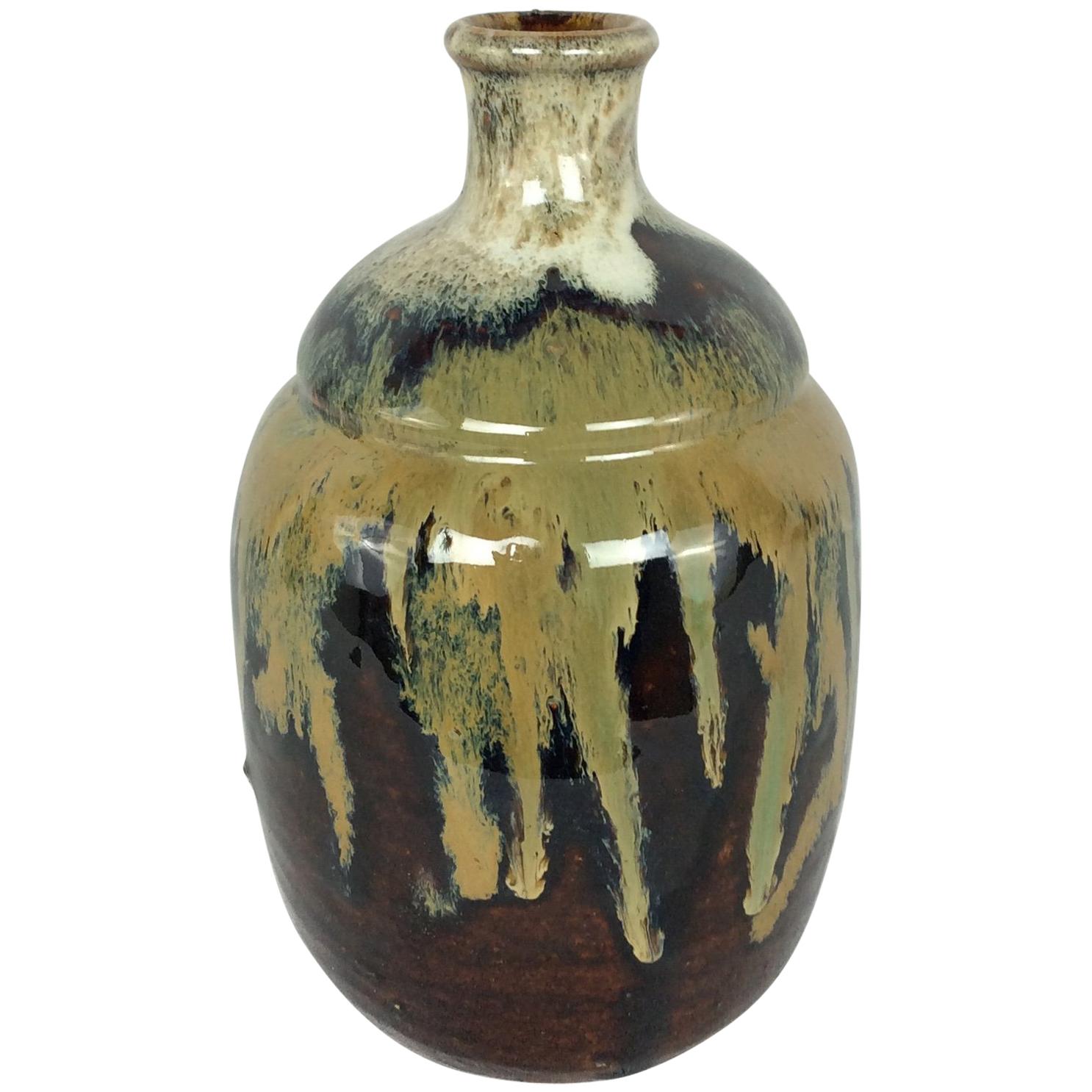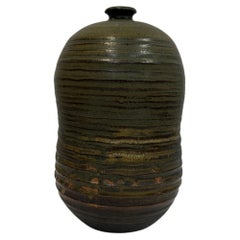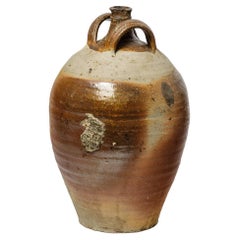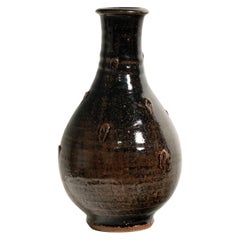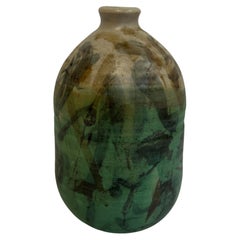Items Similar to JOHN LEOPARD EAST TEXAS 1850-1883 RUSK COUNTY POTTERY STONEWARE HENDERSON TEXAS
Want more images or videos?
Request additional images or videos from the seller
1 of 4
JOHN LEOPARD POTTERYJOHN LEOPARD EAST TEXAS 1850-1883 RUSK COUNTY POTTERY STONEWARE HENDERSON TEXASCirca 1850s 1860s
Circa 1850s 1860s
$12,500
£9,433.41
€10,799.82
CA$17,629.14
A$19,354.60
CHF 10,097.34
MX$234,217.63
NOK 126,554.45
SEK 119,247.56
DKK 80,617.80
About the Item
John Leopard (1800-1883) Pottery
Rusk County Henderson Texas Pottery (1850-1883)
5 or 6 Gallon Ovoid East Texas Churn
18 inches tall
11 inches at widest point
Utilitarian
John Leopard (1800-1883) Pottery Rusk County Henderson Texas Pottery (1850-1883)
One natural resource found in Rusk County provided an abundance of raw material for the development of industry in the county. When pioneers arrived in Rusk County in the early 1800's, they found a variety of clays suitable for brick making, tiles, statuary and pottery. Pottery making is one of the world's oldest crafts, with examples of pottery traced back as far as the 7th century BC. Amongst the earliest finds are artistic figures, images of people and animals, and household implements including breakers and dishes. Anthropologists often use the techniques and patterns found in ancient burial sites to form an accurate picture of society through the ages. Earthenware (jugs, churns, and vessels of all kinds) made in Rusk County found a ready market. Some of the early potters were Brown, Leopard, Rushton, Prothro and Russell. Many of Henderson's downtown buildings were made from bricks baked in the kiln of the Howard Brothers, and many early plantations included kilns for brick making and pottery. One of these early plantation owners was Taylor Brown Sr., who came from Alabama in 1839 to take advantage of an offer from the Republic of Texas to people willing to move their families to Texas. He was searching for a piece of property that could be made into a self-sustaining plantation. Brown settled on a piece of property located on the old Henderson-to-Tyler highway. On this property he constructed Brown's Lake and installed an overshot waterwheel that powered a pottery plant, grist and wheat mill, cotton gin and cabinet factory. The millrace is still visible on the property and clay from the pit was used in this century by Henderson Clay Products Company (now Boral Brick). Henderson Clay Products opened for business on April 21, 1947, and grew to become one of the largest brick making businesses in the United States. Brick from Henderson Clay was used in construction of the Astrodome in Houston. Besides Brown, one of the earliest known Rusk County potters was John Leopard, who operated a pottery 1850-1870 in the Roquemore community located on the Pine Hill Road (Farm-to-Market Road 2867) in the west corner of the road leading to Hunt Cemetery. Legend tells that a group of potters followed a vein of clay from South Carolina through Alabama to Texas. Family histories seem to bear out this legend, as many of Rusk County's potters trace their roots to South Carolina and Alabama. Leopard was one of these South Carolina potters who was born in South Carolinas and migrated to Texas. His grave is located in a pasture east of the Hunt Cemetery. Located near the old Leopard pottery is the site of another early pottery belonging to another South Carolina family that migrated to Alabama. Members of this family moved to Dangerfield at some time between 1850 and 1855 but returned to Alabama. Joseph Clifford Demerval Rushton (Cliff) came to Rusk County about 1869 after service in the Confederate Army during the Civil War. He was a potter, following in his father's footsteps. Great-great granddaughter, Mary Frank Dunn related that Rushton worked for a time in the Brown pottery factory before he bought a farm and built a jug factory beyond Hunt Cemetery. "The Rushtons and the Hunts are related families," said Dunn. "Cliff Rushton's pottery is signed 'JR." The Hunts were another early Rusk County pottery-making family who settled along the vein of clay found in the Roquemore area. Their factory was located near the intersection of Farm-to-Market Roads 840 and 2867. John Fleming Hunt learned his craft at the age of 18 under the tutelage of an old Negro man, according to Fay Hunt. Clay for the Hunt Jug Factory was of a high quality, and after the business closed, an 18-acre clay pit site was purchased by Henderson Clay Products. A potter herself, Fay Hunt learned the trade and worked in the family business before it closed. Many of the firm's secrets were known to her, including how to distinguish the unmarked pottery. "Many people find a Rusk County jug marked 'JH' and think they have a piece of Hunt pottery when what they really have is a piece made by James W. (Jim) Haden," said Hunt. "John Hunt never signed his pottery, but there is a secret marking which only I know." Operated from 1890 until 1932, the factory was closed for a while during the 1930's but reopened during the World War II years of the 1940's, after which it was again closed. Another Henderson clay-based industry was the Henderson Pottery Works. A deed recorded in 1891 shows the property sold to a J.F. Dawson and lists several property sites in an around Henderson including a plot located near the old Brown kiln. Early records show it to be owned by Russell Pottery & M.B. Griffith, believed to be former owners of the Henderson Pottery Works property, although pottery auction legends date this pottery between 1900-1909. A pottery display at the Depot Museum shows examples of churns, jugs and other pottery used in early Rusk County homes.
- Creator:JOHN LEOPARD POTTERY (1880 - 1883, American)
- Creation Year:Circa 1850s 1860s
- Dimensions:Height: 18 in (45.72 cm)Diameter: 11 in (27.94 cm)
- Medium:
- Period:
- Condition:Glaze is ultra excellent for the period. Please view our other Texas Goodies at our 1stdibs storefront.
- Gallery Location:San Antonio, TX
- Reference Number:1stDibs: LU769313773842
About the Seller
5.0
Vetted Professional Seller
Every seller passes strict standards for authenticity and reliability
Established in 1974
1stDibs seller since 2017
102 sales on 1stDibs
Typical response time: 1 hour
- ShippingRetrieving quote...Shipping from: Fredericksburg, TX
- Return Policy
Authenticity Guarantee
In the unlikely event there’s an issue with an item’s authenticity, contact us within 1 year for a full refund. DetailsMoney-Back Guarantee
If your item is not as described, is damaged in transit, or does not arrive, contact us within 7 days for a full refund. Details24-Hour Cancellation
You have a 24-hour grace period in which to reconsider your purchase, with no questions asked.Vetted Professional Sellers
Our world-class sellers must adhere to strict standards for service and quality, maintaining the integrity of our listings.Price-Match Guarantee
If you find that a seller listed the same item for a lower price elsewhere, we’ll match it.Trusted Global Delivery
Our best-in-class carrier network provides specialized shipping options worldwide, including custom delivery.More From This Seller
View AllEXTRA BEAUTIFUL CRACKLE VASE BY MASTER TEXAS GLAZER HARDING BLACK POTTERY
By Harding Black
Located in San Antonio, TX
Harding Black
San Antonio (1912 - 2004)
Huge Heavy Crackle Vase 1985
Height 14''
Across Widest 8"
Biography
Harding Black San Antonio (1912 - 2004)
Harding Black was born on a farm in Nueces County between Ingleside and Aransas Pass and moved with his family to San Antonio in 1916. There he graduated from Brackenridge High School and attended San Antonio Junior College (1929-30). In 1931 Black joined an archaeological expedition to the Big Bend area sponsored by the Witte Memorial Museum. Initially a painter, he was taught by Rudolph Staffel in 1933 to make wheel- thrown pottery and in the same year began to teach children's ceramic classes at the Witte.
Between 1937 and 1939, Black directed ceramic installation in a San Antonio reconstruction project sponsored by the National Youth Administration and the Works Progress Administration art program. In 1955 he retired from teaching and devoted his time to ceramics. Black became a well-known ceramist from his research, innovations, and writings in the field.
Exhibitions: San Antonio Local Artists Annual Exhibition (1939-42, 1945, 1947); Texas General Exhibition (1940 award, 1942, 1948 honorable mention); National Ceramic Annual Exhibition, Syracuse Museum of Art (1947-54); River Art Group, San Antonio (1948-49); National Collection of Fine Arts, Washington D.C. (1951, 1956); Dallas Museum of Fine Arts (1952 one-man); Martin Museum of Art, Baylor University (1991 one-man); San Antonio Museum of Art (1995 retrospective); National Museum of Art, Washington, D.C. (1995); University of Texas at Dallas, Irving (1998 retrospective). Collections: Dallas Museum of Art; Museum of Fine Arts, Houston; San Angelo Museum of Fine Arts; San Antonio Museum of Art; Martin Museum of Art, Baylor University, Waco; National Museum of American Art, Washington D.C.; New Orleans Museum of Art; Everson Museum of Art, Syracuse, new York; Alfred University (New York).
Harding Black resided in San Antonio Texas where he worked as a potter for over 60 years and far as anyone knows he was completely self taught. I find it amazing that anyone could ever accomplish what he did with with no formal training in either ceramics or chemistry. It was a long and prolific journey from the early hand built earthenware pottery to become recognized as a master of glazes. While I feel that his forms often could be better this is more than compensated for by the spectacular glazes he developed. Constant experimentation and his acquired knowledge of chemistry were the foundations for the wonderful glazes that adorn his pottery.
The following quote is from an interview with Rudolf Staffel His copper reds are unbelievably beautiful. Harding was a master of glazes and one of the most generous human beings in the ceramic field that I've known. He had literally a room full of beautifully organized test tiles of all his glazes, and he would just throw the room open to anybody who wanted to rummage through his tiles. All the recipes were there and he shared them with anyone who was interested. It was wonderful to go and visit him. Although accurate records of all test firings were kept for reference it I have been told that it would be difficult to reproduce many of these glazes because of the kiln he built and clays he used. This may not be the case because in a recent phone conversation (4/11/2007) with Peter Pinnell he told me that some of his students had success replicating some glazes using Harding's formulas By concentrating on the bowl and vessel forms Harding remained true to the historical traditions of pottery making.
The magnificent Harding Black journey began in 1932. At that time he joined the Witte Museum Archaeological Society which provided him with access to their collections of Native American pottery. Harding became fascinated by these pollychromed vessels and he began attempting to create hand built pots. He had very little or no success but a life long of working in clay had begun. It was about this time that he met up with Rudolf Staffel and it was from him that Harding learned wheel throwing and developed ideas of how to operate a studio. Harding was given access to working space at the Witte where he built a wheel and in 1933 he was given a position as ceramic instructor. In this position it was his responsibility to establish a ceramics department. The first kiln Harding built was using plans that were obtained from Newcomb College. He scrounged parts from a junkyard which were used in its construction. This project was not totally successful because of problems reaching required temperatures. As usual this did not deter Harding. He seemed to have a wonderful ability to learn from failure and move on.
In the early 1940's Harding began working with formulas for copper red glazes prepared by Arthur Baggs and Edgar Littlefield. This work only added to his interest in Oriental pottery and fostered a desire to rework many old glazes. Being greatly influenced by A Potters Book published in 1940 by Bernard Leach Harding was now on his way seeking to incorporate form, function and surface treatment into a single entity where the whole is greater than the sum of the parts.
In the 1950's Harding left the Witte and built his own studio where he spent the rest of his life creating his wonderful art. The body of his work is a living tribute to the Harding Black lifelong love of ceramics. Along with being a researcher he was also a teacher always willing to share his knowledge with others. He spent his life producing pots and occasionally taking time off to do a bit if fishing. According to Harding Black - Harding Black 11/14/90 "I am one of the lucky ones. When I get up in the morning I can hardly wait to get to work." 1912 Born April 15 near Aransas Pass, Texas 1916 Family moved to San Antonio 1929 Graduated from Breckenridge High School 1929-30 Attended San Antonio Junior College 1931 Joined Archaeological Society of the Witte Museum, San Antonio, and participated in excavations of ancient Basket maker Indian mounds and caves in the Big Bend area of Texas 1933 Taught by Rudolf Staffel to make wheel-thrown pottery. Set tip studio in a streetcar behind Witte Museum and began teaching children’s ceramic classes 1937-39 Appointed Superintendent of Ceramic Installation for N Y A /W P A reconstruction project in San Antonio 1943 Moved from streetcar studio to new facilities in the reconstructed Ruiz House on the grounds of the Witte Museum Began firing to stoneware temperatures 1947-54 Exhibited each year in the annual National Ceramic Exhibition, Syracuse Museum of Art 1951 Exhibited at the National Museum of Art, Washington, DC 1952 Toured ceramic centers throughout the United States 1953 “Opening the Door to Copper-Reds” by Harding Black, published in January issue of Ceramics Monthly “Harding Black Profile” published in February issue of Ceramics Monthly 1954 “Iron Spotted Glazes” by Harding Black, published in February issue of Ceramics Monthly 1955 Built present studio at 8212 Broadway, San Antonio Retired from teaching at the Witte Museum 1956 Exhibited at the National Museum of Art, Washington, DC 1961 “Lava Glazes” by Harding Black, published in October issue of Ceramics Monthly 1964 “Harding Black Texas Potter” by Jean R Lange, published in November issue of Ceramics Monthly 1971 The Meyer Family Master Potters of Texas, co-authored by Harding Black and Georgeanna H Greet 1980 Harding Black’s biographical information entered into the archives of the Smithsonian Institution, Washington, D C 1983 Harding Black traveled throughout China 1984 Awarded Glaze Research Grant by Southwest Craft Center, San Antonio 1985 Solo exhibition at the Southwest Crafts Center 1987 Selected as Artist of the Year by the San Antonio Art League 1988 Incarnate Word College, San Antonio, establishes Harding Black Fund to aid ceramics students 1990 “Harding Black Pottery...
Category
1980s Modern More Art
Materials
Ceramic
"Huge Oxblood Vase" Beautiful from Texas Master Glazer Harding Black
By Harding Black
Located in San Antonio, TX
Harding Black
San Antonio (1912 - 2004)
Huge Heavy Oxblood Vase 1984
Height 17''
At widest 5''
Biography
Harding Black San Antonio (1912 - 2004)
Harding Black was born on a farm in Nueces County between Ingleside and Aransas Pass and moved with his family to San Antonio in 1916. There he graduated from Brackenridge High School and attended San Antonio Junior College (1929-30). In 1931 Black joined an archaeological expedition to the Big Bend area sponsored by the Witte Memorial Museum. Initially a painter, he was taught by Rudolph Staffel in 1933 to make wheel- thrown pottery and in the same year began to teach children's ceramic classes at the Witte.
Between 1937 and 1939, Black directed ceramic installation in a San Antonio reconstruction project sponsored by the National Youth Administration and the Works Progress Administration art program. In 1955 he retired from teaching and devoted his time to ceramics. Black became a well-known ceramist from his research, innovations, and writings in the field.
Exhibitions: San Antonio Local Artists Annual Exhibition (1939-42, 1945, 1947); Texas General Exhibition (1940 award, 1942, 1948 honorable mention); National Ceramic Annual Exhibition, Syracuse Museum of Art (1947-54); River Art Group, San Antonio (1948-49); National Collection of Fine Arts, Washington D.C. (1951, 1956); Dallas Museum of Fine Arts (1952 one-man); Martin Museum of Art, Baylor University (1991 one-man); San Antonio Museum of Art (1995 retrospective); National Museum of Art, Washington, D.C. (1995); University of Texas at Dallas, Irving (1998 retrospective). Collections: Dallas Museum of Art; Museum of Fine Arts, Houston; San Angelo Museum of Fine Arts; San Antonio Museum of Art; Martin Museum of Art, Baylor University, Waco; National Museum of American Art, Washington D.C.; New Orleans Museum of Art; Everson Museum of Art, Syracuse, new York; Alfred University (New York).
Harding Black resided in San Antonio Texas where he worked as a potter for over 60 years and far as anyone knows he was completely self taught. I find it amazing that anyone could ever accomplish what he did with with no formal training in either ceramics or chemistry. It was a long and prolific journey from the early hand built earthenware pottery to become recognized as a master of glazes. While I feel that his forms often could be better this is more than compensated for by the spectacular glazes he developed. Constant experimentation and his acquired knowledge of chemistry were the foundations for the wonderful glazes that adorn his pottery.
The following quote is from an interview with Rudolf Staffel His copper reds are unbelievably beautiful. Harding was a master of glazes and one of the most generous human beings in the ceramic field that I've known. He had literally a room full of beautifully organized test tiles of all his glazes, and he would just throw the room open to anybody who wanted to rummage through his tiles. All the recipes were there and he shared them with anyone who was interested. It was wonderful to go and visit him. Although accurate records of all test firings were kept for reference it I have been told that it would be difficult to reproduce many of these glazes because of the kiln he built and clays he used. This may not be the case because in a recent phone conversation (4/11/2007) with Peter Pinnell he told me that some of his students had success replicating some glazes using Harding's formulas By concentrating on the bowl and vessel forms Harding remained true to the historical traditions of pottery making.
The magnificent Harding Black journey began in 1932. At that time he joined the Witte Museum Archaeological Society which provided him with access to their collections of Native American pottery. Harding became fascinated by these pollychromed vessels and he began attempting to create hand built pots. He had very little or no success but a life long of working in clay had begun. It was about this time that he met up with Rudolf Staffel and it was from him that Harding learned wheel throwing and developed ideas of how to operate a studio. Harding was given access to working space at the Witte where he built a wheel and in 1933 he was given a position as ceramic instructor. In this position it was his responsibility to establish a ceramics department. The first kiln Harding built was using plans that were obtained from Newcomb College. He scrounged parts from a junkyard which were used in its construction. This project was not totally successful because of problems reaching required temperatures. As usual this did not deter Harding. He seemed to have a wonderful ability to learn from failure and move on.
In the early 1940's Harding began working with formulas for copper red glazes prepared by Arthur Baggs and Edgar Littlefield. This work only added to his interest in Oriental pottery and fostered a desire to rework many old glazes. Being greatly influenced by A Potters Book published in 1940 by Bernard Leach Harding was now on his way seeking to incorporate form, function and surface treatment into a single entity where the whole is greater than the sum of the parts.
In the 1950's Harding left the Witte and built his own studio where he spent the rest of his life creating his wonderful art. The body of his work is a living tribute to the Harding Black lifelong love of ceramics. Along with being a researcher he was also a teacher always willing to share his knowledge with others. He spent his life producing pots and occasionally taking time off to do a bit if fishing. According to Harding Black - Harding Black 11/14/90 "I am one of the lucky ones. When I get up in the morning I can hardly wait to get to work." 1912 Born April 15 near Aransas Pass, Texas 1916 Family moved to San Antonio 1929 Graduated from Breckenridge High School 1929-30 Attended San Antonio Junior College 1931 Joined Archaeological Society of the Witte Museum, San Antonio, and participated in excavations of ancient Basket maker Indian mounds and caves in the Big Bend area of Texas 1933 Taught by Rudolf Staffel to make wheel-thrown pottery. Set tip studio in a streetcar behind Witte Museum and began teaching children’s ceramic classes 1937-39 Appointed Superintendent of Ceramic Installation for N Y A /W P A reconstruction project in San Antonio 1943 Moved from streetcar studio to new facilities in the reconstructed Ruiz House on the grounds of the Witte Museum Began firing to stoneware temperatures 1947-54 Exhibited each year in the annual National Ceramic Exhibition, Syracuse Museum of Art 1951 Exhibited at the National Museum of Art, Washington, DC 1952 Toured ceramic centers throughout the United States 1953 “Opening the Door to Copper-Reds” by Harding Black, published in January issue of Ceramics Monthly “Harding Black Profile” published in February issue of Ceramics Monthly 1954 “Iron Spotted Glazes” by Harding Black, published in February issue of Ceramics Monthly 1955 Built present studio at 8212 Broadway, San Antonio Retired from teaching at the Witte Museum 1956 Exhibited at the National Museum of Art, Washington, DC 1961 “Lava Glazes” by Harding Black, published in October issue of Ceramics Monthly 1964 “Harding Black Texas Potter” by Jean R Lange, published in November issue of Ceramics Monthly 1971 The Meyer Family Master Potters of Texas, co-authored by Harding Black and Georgeanna H Greet 1980 Harding Black’s biographical information entered into the archives of the Smithsonian Institution, Washington, D C 1983 Harding Black traveled throughout China 1984 Awarded Glaze Research Grant by Southwest Craft Center, San Antonio 1985 Solo exhibition at the Southwest Crafts Center 1987 Selected as Artist of the Year by the San Antonio Art League 1988 Incarnate Word College, San Antonio, establishes Harding Black Fund to aid ceramics students 1990 “Harding Black Pottery...
Category
1980s Modern More Art
Materials
Ceramic
Large Sgraffito Planters Mid Century Modern
Located in San Antonio, TX
These are most likely made by Harding Black of one of his fellow local San Antonio Texas potters. They are unsigned but the shape is Harding Black. Regardless they are pretty fantastic Sgraffito...
Category
1960s Contemporary More Art
Materials
Ceramic
Large Wood Turned Hackberry Vase. Turned and Dyed. Master Wood Turner Carmie
By Carmie
Located in San Antonio, TX
Carmie (1959-) Large Hackberry Vase, Height 12" Diameter 6''
Bio
Carmie (1959-)
Wood Turner Carmie K. Acosta was born and raised in San Antonio. By day he works as a synthetic organic chemist specializing in steroid synthesis. His foray into wood turning began in the year 2000 when his father passed away. Growing up, he was surrounded by wood working and the associated wood working tools...
Category
2010s Modern More Art
Materials
Wood
Charles B Fletcher St. Louis Horn Furniture Maker Rare Horn Table Original 1880s
Located in San Antonio, TX
Charles B. Fletcher Has original upholstery
St. Louis Horn Furniture Maker
Rare Horn Table Original upholstery
Top is 20 x 20
Height is 30 inches
Details
Made from Buffalo and Cattle Horns. It is extremely difficult to find Horn Tables. Circa 1880s
Horn Furniture
Biography
Charles B. Fletcher St. Louis Horn Furniture Maker
Charles Fletcher and John Crane, both of St. Louis, made furniture as a business. Makers, such as Wenzel Friedrich...
Materials
Animal Skin
Mesquite hollow form vase/bowl. Natural Art Wood Turning
By Carmie
Located in San Antonio, TX
Carmie (Born 1959) Rustic Mesquite Hollow Form Vase/Bowl Height 4.5" Diameter 5''Biography
Bio
Carmie (1959-)
Wood Turner Carmie K. Acosta w...
Category
2010s Modern More Art
Materials
Wood
You May Also Like
Earthenware Vessel - Artist Unknown
Located in Alpha, NJ
This beautiful earthenware vessel is in very good overall condition. Resembling the style of Toshiko Takaezu pottery. Measuring 9.5" tall by 5"...
Category
21st Century and Contemporary North American Pottery
Materials
Clay
Large 19th Century Stoneware Ceramic from La Borne Pottery French Handmade
By La Borne Potters
Located in Neuilly-en- sancerre, FR
La Borne - 19th century
Large stoneware pottery from center of France
Realised circa 1880
Original good condition
its peculiarity is to have a piece of another pot fixed...
Category
Antique Late 19th Century French Brutalist Ceramics
Materials
Ceramic
Jim Malone, Stoneware Ceramic Vase
By Jim Malone
Located in London, GB
Tenmoku and kaki stoneware glaze
H29 cm
Category
20th Century Ceramics
Materials
Stoneware
Ceramic Vessel - Artist Unknown
Located in Alpha, NJ
The beautiful ceramic vessel is in very good overall condition. Measuring 6" tall and 3.75" wide. Resembling and in the style of Toshiko Takaezu. Acquired in the New Hope, PA area.
Category
21st Century and Contemporary American Pottery
Materials
Clay
John Tuska Lidded Stoneware Vessel
By John Tuska
Located in Palm Springs, CA
John Tuska lidded stoneware vessel in a striking green glaze.
John Tuska, full name John Regis Tuska, (1931–1998) was an American artist and educator. H...
Category
20th Century American Aesthetic Movement Ceramics
Materials
Terracotta
$1,760 Sale Price
20% Off
19th Century Japanese Stoneware Saki Jar Vessel
Located in Miami, FL
A large heavily glazed stoneware saki jar or pot.
This traditional Japanese piece has wonderful colors and a beautiful shape, 19th century.
Category
Antique 19th Century Japanese Jars
Materials
Ceramic
